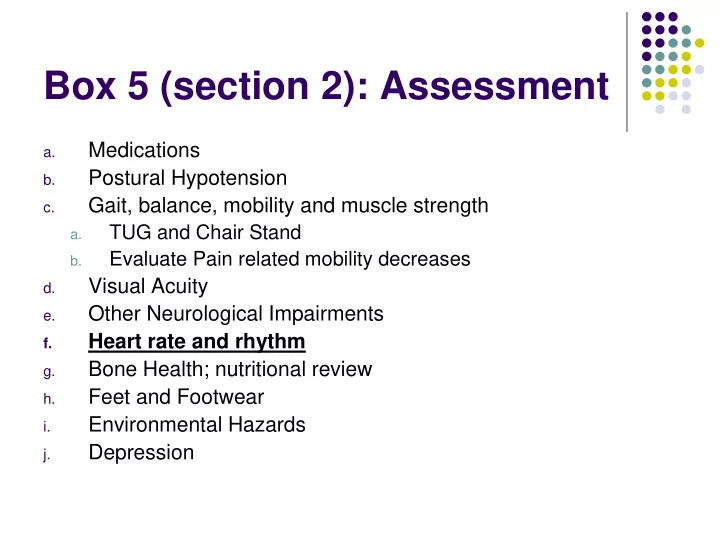

Box 5 (section 2): Assessment Medications a. Postural Hypotension b. Gait, balance, mobility and muscle strength c. TUG and Chair Stand a. Evaluate Pain related mobility decreases b. Visual Acuity d. Other Neurological Impairments e. Heart rate and rhythm f. Bone Health; nutritional review g. Feet and Footwear h. Environmental Hazards i. Depression j.
Box 5 – 2f. Heart rate / rhythm + blood flow Decreased Cardiac Output Blockage of blood flow 1. Valvular 1. aortic or mitral stenosis 1. Subaortic stenosis 2. Aortic dissection 3. Pulmonary Embolus 2. Arrhythmia 2. Tachycardia (inadequate time in diastole for heart to fill): VT, SVT, WPW, VF, AFIB … Bradycardia; SSS, conduction blocks (complete heart block) Can be precipitated by digoxin, beta-blocker (including Timoptic /Timolol eye drops), Alzheimer medications (Cholinesterase Inhibitors), Ca Channel Blockers Carotid Sinus Hypersensitivity Very low Left Ventricular Ejection Fraction 3.
Box 5 – 2f. Heart rate / rhythm + blood flow VASOVAGAL - Syncope Triggered by: Stress Any painful or unpleasant stimuli, such as: Venepuncture Hitting your funny bone Experiencing medical procedures with local anesthesia Post-surgical pain when standing up or moving too abruptly after the procedure Giving or receiving a needle immunization Watching someone give blood Watching someone experience pain Watching or experiencing medical procedures Sight of blood Occasions of slight discomfort, such as dental and eye examinations Sudden onset of extreme emotions Nausea or vomiting Urination ('micturition syncope') or defecation, having a bowel movement ('defecation syncope') Abdominal straining or 'bearing down' Swallowing ('swallowing syncope') or coughing ('cough syncope') Pressing upon certain places on the throat, sinuses, and eyes, also known as vagal reflex stimulation when performed clinically etc
Recommend
More recommend